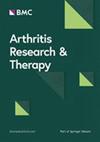基于DNA甲基化的类风湿关节炎诊断算法
IF 4.6
2区 医学
Q1 Medicine
引用次数: 0
摘要
类风湿关节炎(RA),特别是血清阴性疾病,很难早期诊断,这可能会延迟治疗的开始。本研究旨在建立一种基于二元DNA甲基化(DNAm)的RA诊断算法。从1366人(treatment-naïve RA,其他炎症/自身免疫性疾病,健康个体)的DNAm档案中构建了三个数据集(发现,训练,保留)。使用发现集确定了区分RA与其他炎症/自身免疫性疾病和健康个体的DNAm特征。我们的分类算法是在训练集中使用机器学习技术开发的。在包含RA病例(15例血清阳性,6例血清阴性)和对照组(14例其他关节炎,11例健康个体)的对照组中,评估其诊断性能,无论有无血清学状态。我们的算法包含391个DNAm特征。结合血清学状况,将RA与对照组进行分类,灵敏度为0.90 [95% CI: 0.70-0.99],特异性为0.88 [95% CI: 0.69-0.97], AUC为0.96 [95% CI: 0.91-1.00]。该方法对血清阴性RA患者与其他关节炎患者进行分类的灵敏度为0.83 [95% CI: 0.36-1.00],特异性为0.79 [95% CI: 0.49-0.95], AUC为0.81 [95% CI: 0.61-1.00]。目前基于dna的分类算法可能对RA的早期诊断有临床价值,特别是对血清阴性患者的早期诊断,这是目前诊断的一个挑战。本文章由计算机程序翻译,如有差异,请以英文原文为准。
A DNA methylation-based algorithm for diagnosing rheumatoid arthritis
Rheumatoid arthritis (RA), particularly seronegative disease, is difficult to diagnose early, which can delay treatment initiation. This study aims to develop a binary DNA methylation (DNAm)-based algorithm to diagnose RA. Three datasets (discovery, training, holdout) were constructed from DNAm profiles from 1366 persons (treatment-naïve RA, other inflammatory/autoimmune diseases, healthy individuals). DNAm features that differentiate RA from other inflammatory/autoimmune diseases and healthy individuals were identified using the discovery set. Our classification algorithm was developed using machine learning techniques in the training set. Its diagnostic performance, with and without serological status, was evaluated in the holdout set containing RA cases (15 seropositive, 6 seronegative) and controls (14 other arthritides, 11 healthy individuals). Our algorithm included 391 DNAm features. Combined with serological status, it classified RA from controls in the holdout set with the following performance: sensitivity 0.90 [95% CI: 0.70–0.99], specificity 0.88 [95% CI: 0.69–0.97], and AUC 0.96 [95% CI: 0.91–1.00]. Its performance in classifying patients with seronegative RA versus those with other arthritides was: sensitivity 0.83 [95% CI: 0.36–1.00], specificity 0.79 [95% CI: 0.49–0.95], and AUC 0.81 [95% CI: 0.61–1.00]. The present DNAm-based classification algorithm may be clinically useful for the early diagnosis of RA, especially in seronegative patients, which currently often poses a diagnostic challenge.
求助全文
通过发布文献求助,成功后即可免费获取论文全文。
去求助
来源期刊

Arthritis Research & Therapy
RHEUMATOLOGY-
CiteScore
8.60
自引率
2.00%
发文量
261
审稿时长
14 weeks
期刊介绍:
Established in 1999, Arthritis Research and Therapy is an international, open access, peer-reviewed journal, publishing original articles in the area of musculoskeletal research and therapy as well as, reviews, commentaries and reports. A major focus of the journal is on the immunologic processes leading to inflammation, damage and repair as they relate to autoimmune rheumatic and musculoskeletal conditions, and which inform the translation of this knowledge into advances in clinical care. Original basic, translational and clinical research is considered for publication along with results of early and late phase therapeutic trials, especially as they pertain to the underpinning science that informs clinical observations in interventional studies.
 求助内容:
求助内容: 应助结果提醒方式:
应助结果提醒方式:


